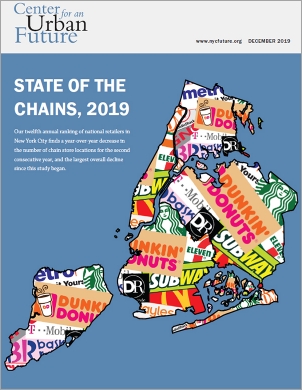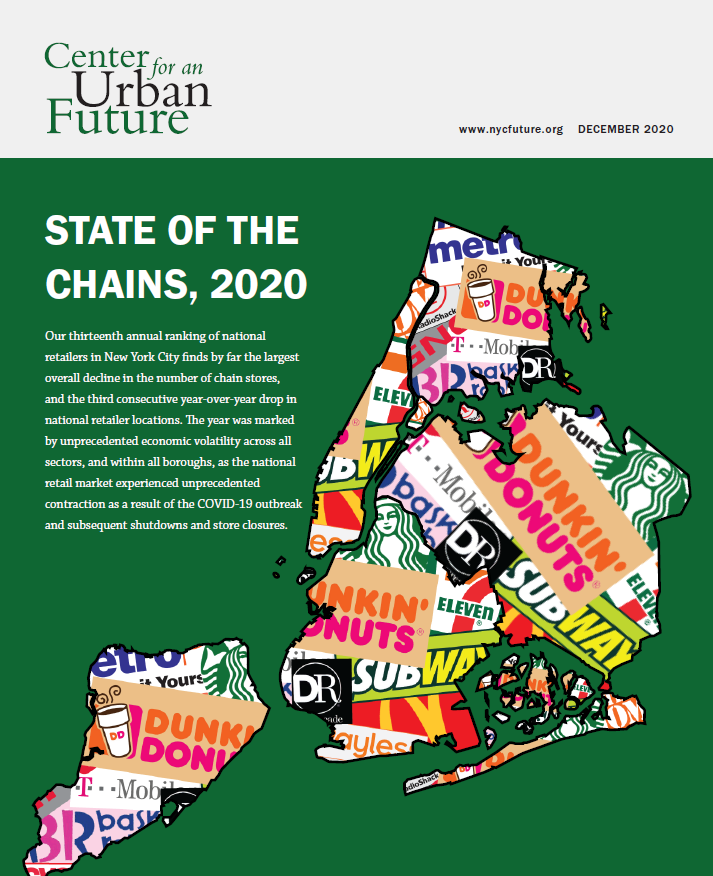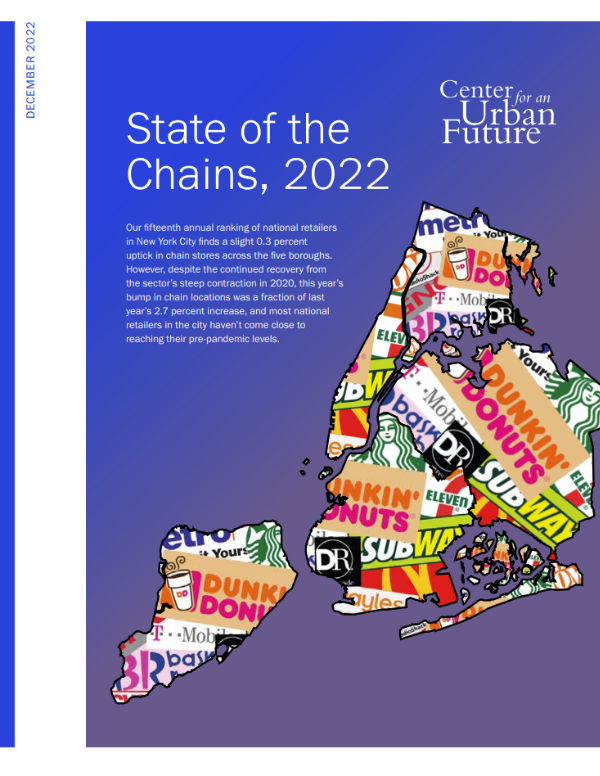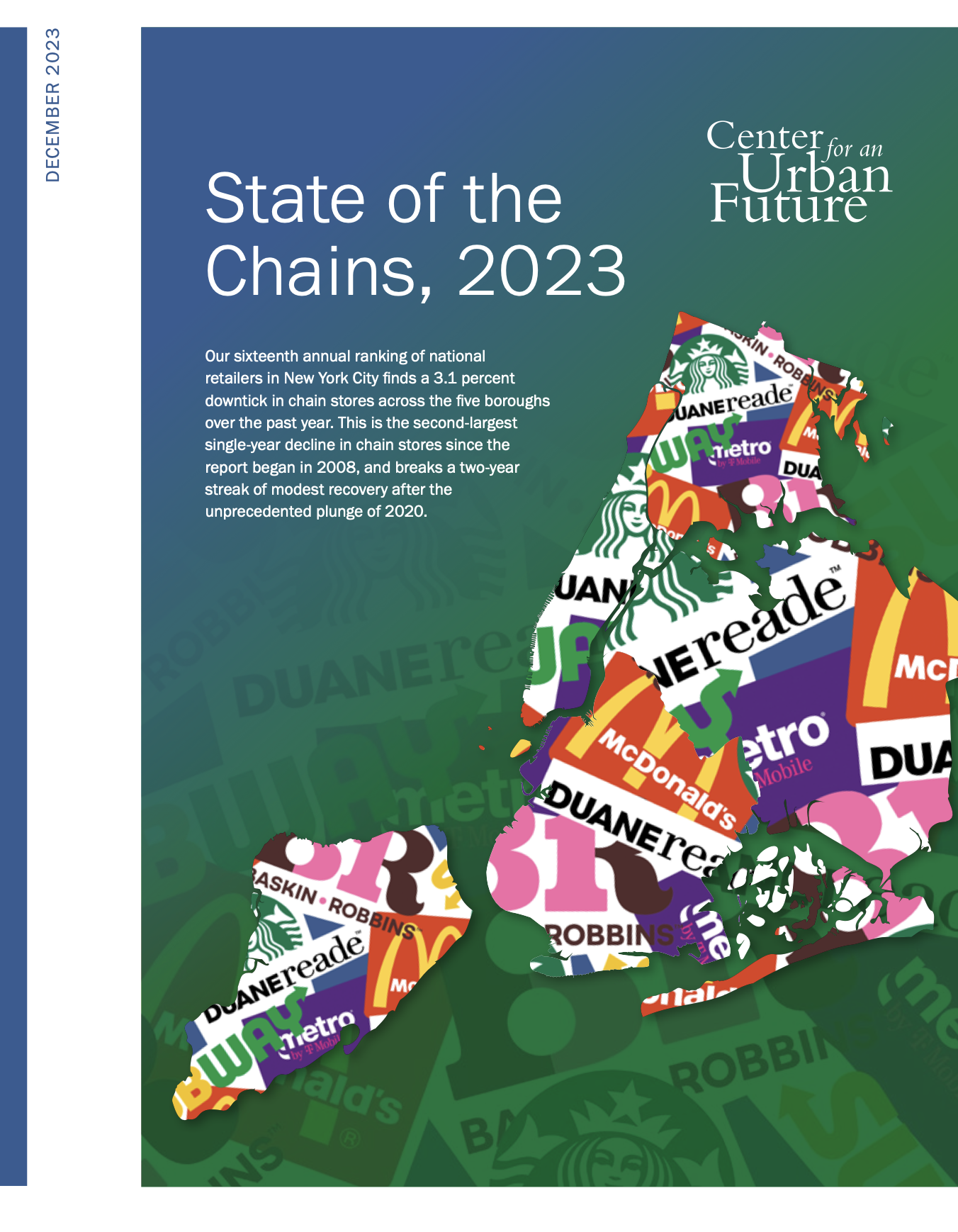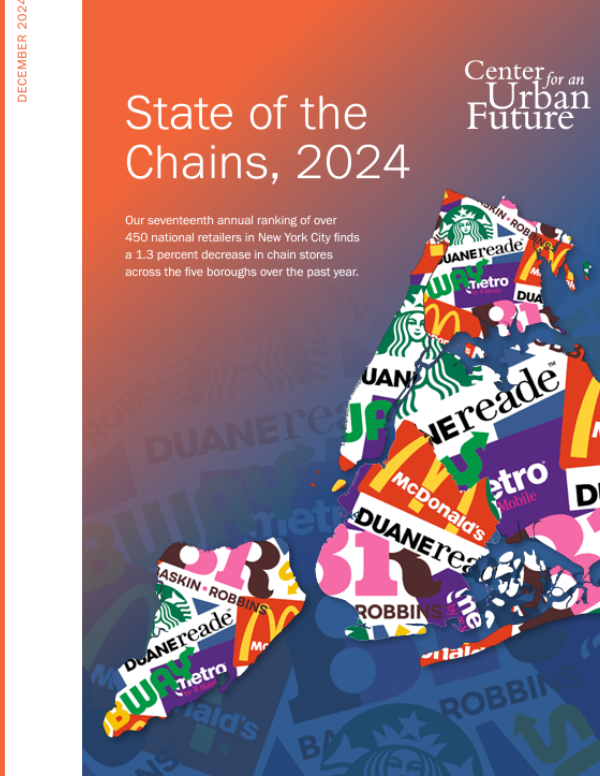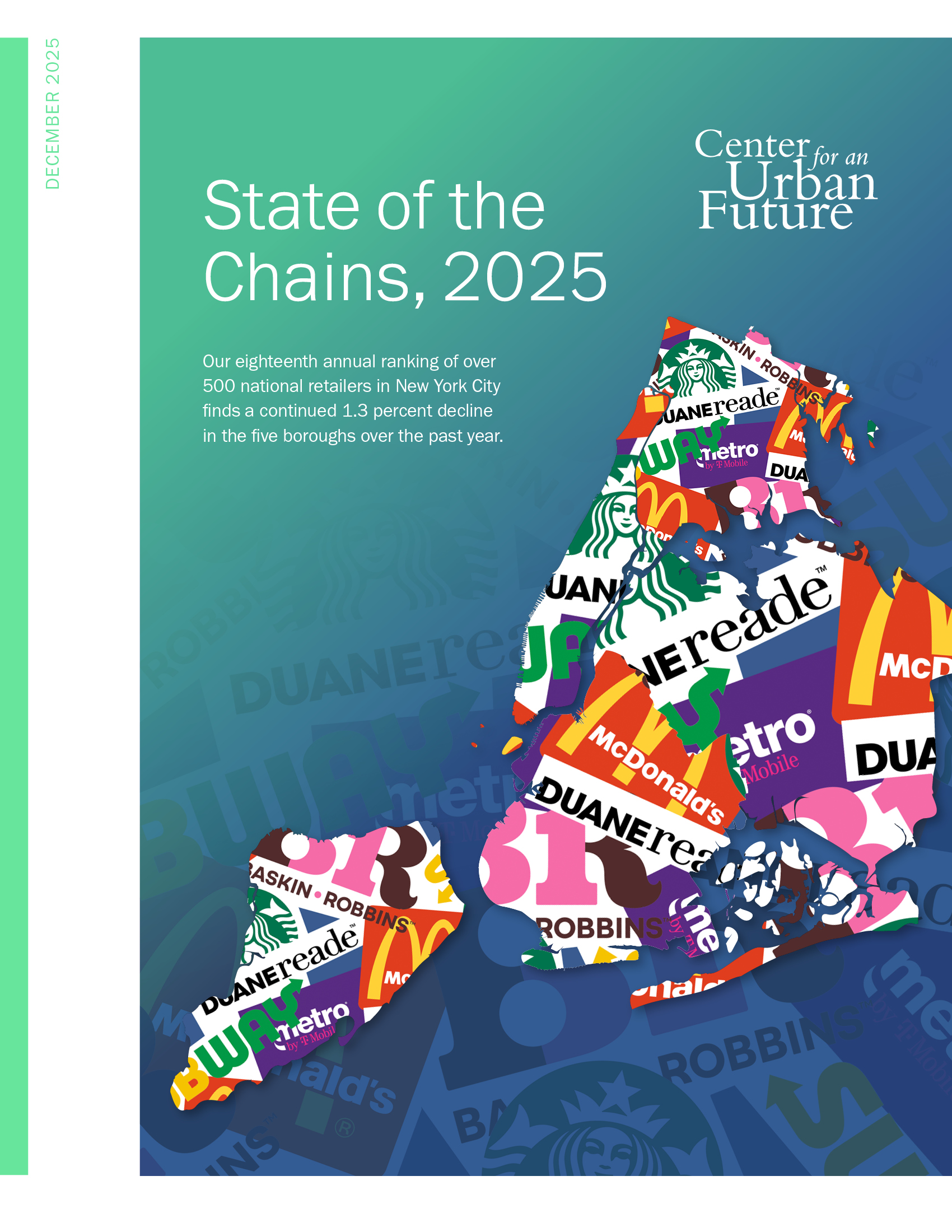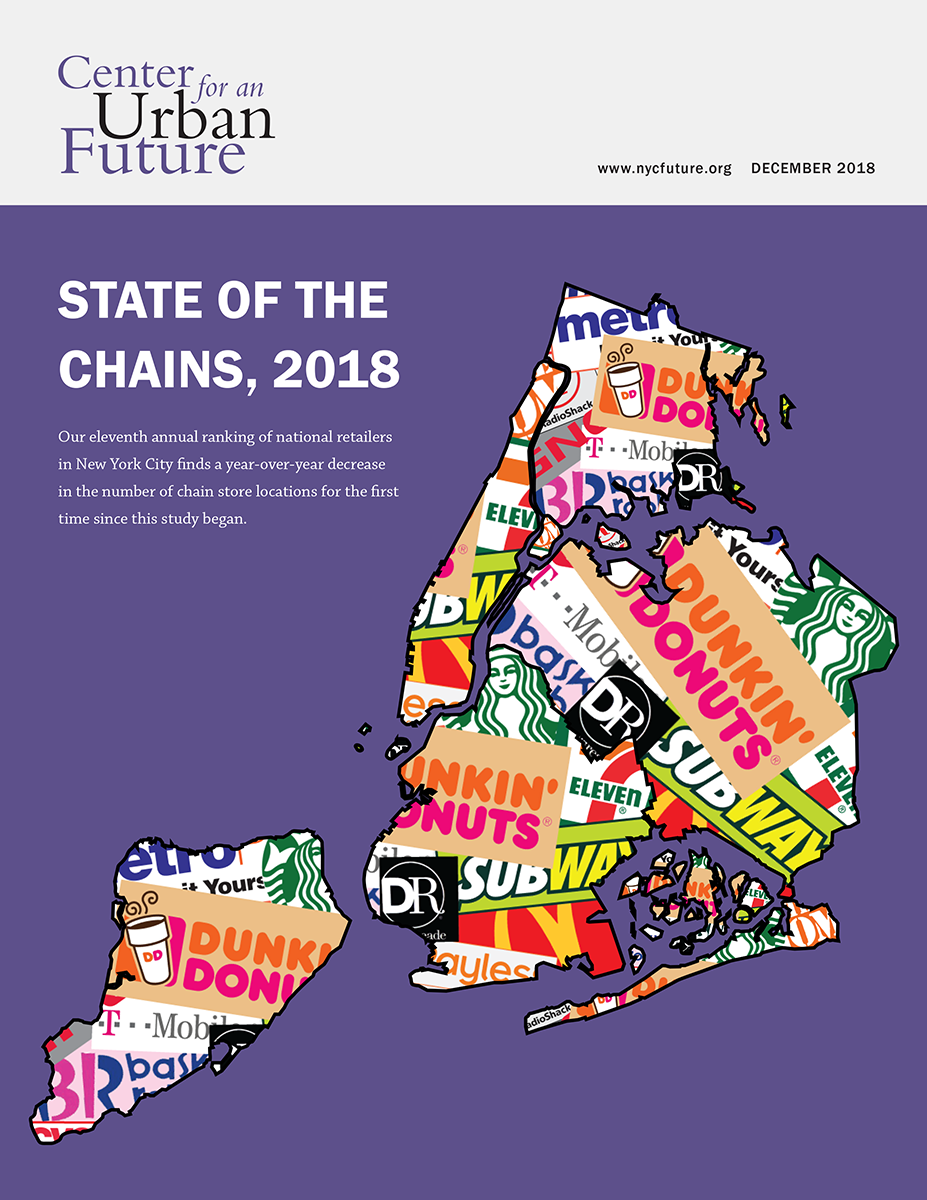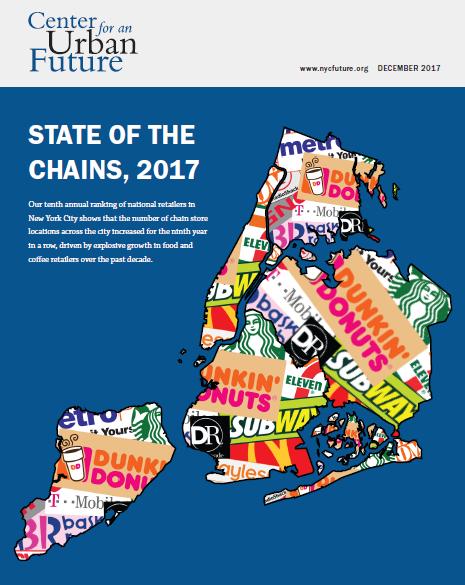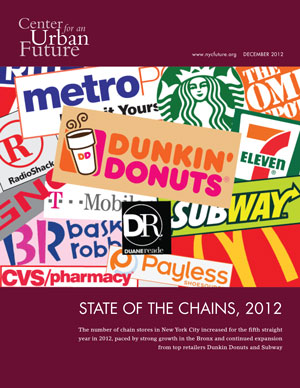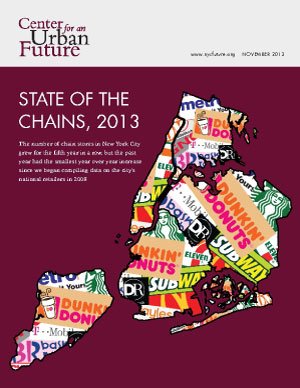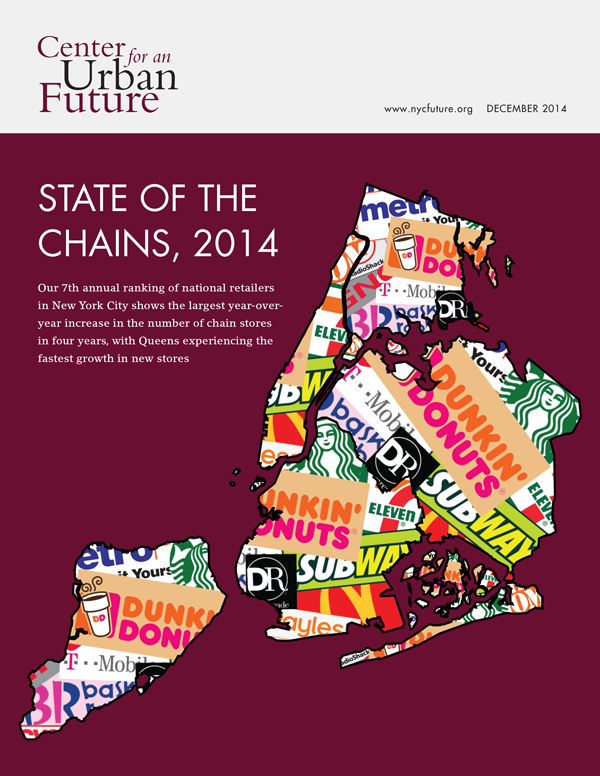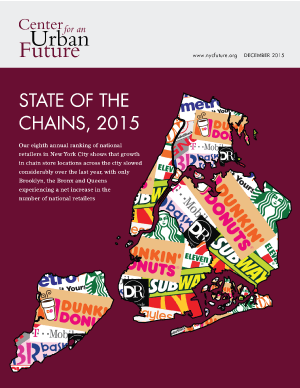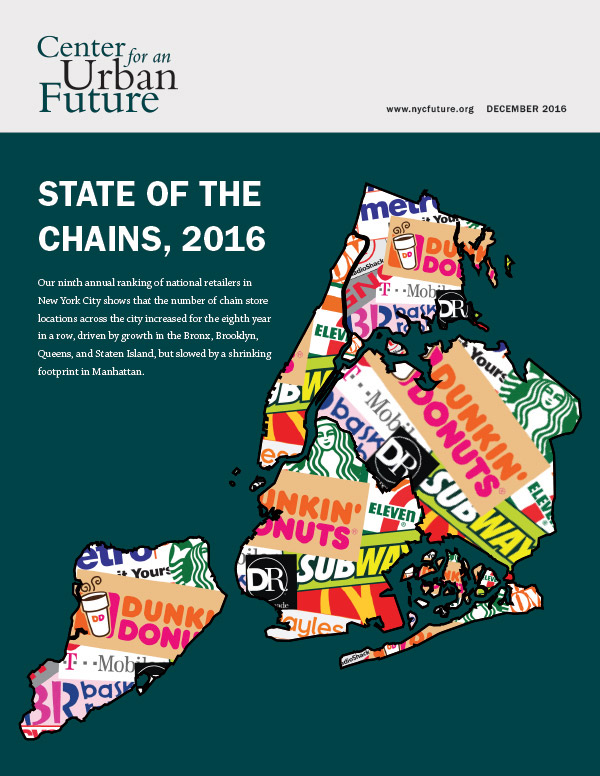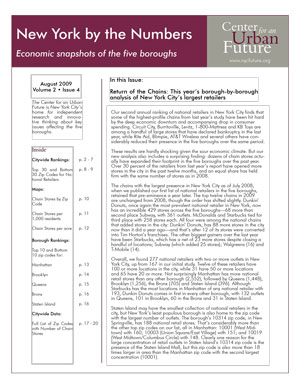Click here to download the full report
The number of chain stores in New York City declined by 3.7 percent over the past year, marking the largest year-over-year drop in national retail locations since the Center for an Urban Future began our annual analysis of the city’s chain retailers more than a decade ago.
Our twelfth annual analysis of national retailer locations in New York shows that the 316 retailers listed in last year’s ranking reduced their total footprint in New York City by 304 store locations, declining from a total of 8,136 stores in 2018 to 7,832 stores in 2019—a 3.7 percent decrease.
The slowdown is broadly spread among all five boroughs, led by Queens, where the number of chain store locations shrank by 4.9 percent—the sharpest single year decline to date—followed by Brooklyn (-4 percent), the Bronx (-3.8 percent), Manhattan (-3.1 percent), and Staten Island (-2.4 percent). This is the first year in which all five boroughs have registered declines.
Overall, our analysis also finds that more of the city’s chain retailers are shrinking than are growing. In 2019, a total of 114 retailers—36 percent of the 316 national retail companies tracked in our 2019 study—reduced their footprint over the past year. This compares to 76 retailers that registered a net gain in stores over the past year, and 126 retailers whose footprints remain unchanged.
We first observed significant declines in the number of national retail locations over the past two years, with most decreases concentrated among merchandise retailers: chain stores selling clothing, accessories, cosmetics, and other household supplies. Even amid that pullback, our research showed that food retailers continued to grow across the five boroughs through 2018. But this year we see notable declines among both merchandise retailers and food chains, with broad-based declines among fast food restaurants, pizza shops, juice bars, ice cream and yogurt chains, and bakeries. The difference is that many other national food chains have continued to expand in the city, while that generally has not been the case for merchandise retailers.
- Food chains with declines include: Subway1 (which reduced its footprint in the city by 43 locations), Golden Krust (-15), Little Caesar’s (-11), Two Boots Pizza (-7), Au Bon Pain (-6), Famous Famiglia (-5), Auntie Anne’s Pretzels (-4), Pizza Hut (-4), McDonald’s (-4), Boston Market (-4), Domino’s Pizza (-3), Applebee’s (-3), KFC (-3), Bareburger (-3), Le Pain Quotidien (-2), Cosi (-2), Hale & Hearty Soups (-2), Nathan’s Famous (-2), Red Robin (-2), Wendy’s (-1), IHOP (-1), TGI Friday’s (-1), Blimpie Subs & Salads (-1), ’Wichcraft (-1), Johnny Rockets (-1), Maoz Vegetarian (-1), Umami Burger (-1), Panda Express (-1), Tim Hortons (-1), Moe’s Southwest Grill (-1), Pollo Campero (-1), and Pax Wholesome Foods (-1).
- Ice cream and yogurt stores with declines include: Baskin-Robbins (-10), Red Mango (-6), and 16 Handles (-1).
- Juice bars with declines include: Jamba Juice (-3), Liquiteria (-2), and Juice Press (-1).
Facing growing competition from e-commerce, merchandise retailers selling clothing, shoes, accessories, jewelry, cosmetics, pet supplies, and vitamins also posted pronounced declines, driven by major store closures including shoe retailer Payless, which shuttered all 71 of its locations, after filing for bankruptcy in February of this year,2 and beauty supply and accessories chain Ricky’s (-12), which closed all but two of its New York City locations.3 Other notable declines include Mattress Firm (-20) and vitamin retailer GNC (-8).
- Clothing retailers with declines over the past year include: Avenue (losing 6 store locations),4 Dress Barn (-4), Charlotte Russe (-4), Children’s Place (-3), J. Crew (-3), Gymboree (-3), Lululemon Athletica (-2), Banana Republic (-2), Express (-2), Hugo Boss (-2), Diesel (-2), Rainbow (-1), Gap (including GapKids & BabyGap) (-1), V.I.M. (-1), Forever 21 (-1), Men’s Warehouse (-1), Eileen Fisher (-1), Brooklyn Industries (-1), Free People (-1), Ann Taylor (-1), White House/Black Market (-1), Chico’s (-1), and Bebe (-1).
- Shoe companies with declines include: Payless Shoes (which closed all 71 of its NYC stores), Steve Madden (-2), Johnston & Murphy (-1), Foot Locker (-1), Skechers (-1), and Famous Footwear (-1).
- Beauty supply and accessories stores with reductions include: Ricky’s (-12), Art of Shaving (-2), Crabtree & Evelyn (-2), and L’Occitane (-1)
- Other merchandise retailers with declines include: Mattress Firm (-20), GNC (-8), GameStop (-7), Edible Arrangements (-4), Party City (-3), Modell’s (-2), Yankee Candle (-1), and FYE (-1).
Dunkin’ Donuts is the biggest national retailer in the city for the twelfth year running, with 636 locations, gaining 12 locations since last year. The second-largest retailer remains MetroPCS (now called Metro by T-Mobile, but retaining a distinct brand) with 468 locations, down from 471 last year, and followed by Starbucks with 351 locations, which increased its total by 24 locations since last year. Having bought out Duane Reade and acquired parts of Rite Aid,5 pharmacy giant Walgreens is now the fourth-largest retailer in New York City with 317 locations, while also posting the single largest gain in store locations among all retailers with 54 new stores. Notably, Rite Aid (-58) dropped significantly, as Walgreens closed or absorbed many of the pharmacy retailer’s locations.6 Rounding out the top 5 is Subway (-43), falling from third place a year ago, down to 287 locations.
Only five retailers grew by more than 10 locations: Duane Reade/Walgreens, Starbucks, AT&T, Dunkin’ Donuts, and CVS.
The biggest gains by category were among coffee and tea shops, which added 45 stores citywide since last year. Among this group, only Argo Tea (-3) dropped in store locations, with Starbucks (+24), Dunkin’ Donuts (+12), Vivi Bubble Tea (+5), Gong Cha (+3), Kung Fu Tea (+2), Blue Bottle Coffee (+1), and Joe Coffee (+1) all adding locations. There were also notable gains among some beauty supply chains as well as gains for certain chain food retailers, with increases among a few traditional fast food restaurants, and continued growth by fast casual chains.
- Traditional fast food chain restaurants that added stores include: Taco Bell (+8), Chick-fil- a (+6), Popeye’s (+6), Checkers (+3),Burger King (+1), and Arby’s (+1).
- Fast casual chains increasing their footprint include: Dig Inn (+6), Sweetgreen (+4), Shake Shack (+3), Chop’t Salad (+2), Pret A Manger (+1), Just Salad (+1), Wingstop (+1), Qdoba Mexican Eats (+1), Olive Garden (+1), 5 Napkin Burger (+1), Totto Ramen (+1).
Last year’s fastest-growing sector, cellular telephone services, slowed this year, with only AT&T (+18) gaining in locations. Sprint (-17), T-Mobile (-7), Verizon Wireless (-5), and MetroPCS (-3), all declined. Eight retailers closed all of their locations within the five boroughs, for a net loss of 146 stores, with Payless Shoes (-71) and Petland Discounts (-60) accounting for most of this decline. Other retailers closing all locations in the city since last year: Avenue, Gymboree, Crabtree & Evelyn, Red Robin, Bebe, and FYE.
Retailer trends since last year
For the eleventh consecutive year, Dunkin’ Donuts tops our list as the largest national retailer in New York City, with a total of 636 stores, a net increase of 12 stores since 2018. MetroPCS is still the second-largest national retailer in the city, with 468 stores, despite losing 3 stores over the past year. Rounding out the top ten national retailers in New York are Starbucks (with 351 stores), Duane Reade/Walgreens (317), Subway (287), T-Mobile (245), Baskin-Robbins (217), McDonald’s (203), CVS (170) and 7-Eleven (141). There are 15 retailers with at least 100 stores across the city, down only 1 from last year.7
The number of chain stores decreased by 3.1 percent in Manhattan, which amounts to a loss of 91 locations. In contrast to last year, when Manhattan was the only borough to show decline, this year all five boroughs registered declines. Queens posted the sharpest drop with a 4.9 percent decrease in chain stores, for a net loss of 91 locations. Similarly, Brooklyn posted a 4 percent decline, losing 71 store locations. Last year’s two fastest-growing boroughs, the Bronx and Staten Island, each recorded significant decline in 2019 (-3.8 percent, or a loss of 40 stores in the Bronx, and -2.4 percent, or a loss of 11 stores on Staten Island).
Starbucks has more stores in Manhattan than any other national retailer, with 231 locations. MetroPCS has 159 locations in Brooklyn and 106 locations in the Bronx, making it the top retailer in both boroughs. In Queens, and on Staten Island, Dunkin’ Donuts retains its lead, with 194 locations and 36 locations, respectively. Among the large pharmacy chains, Duane Reade/Walgreens has become the top pharmacy in all boroughs except Staten Island, where CVS/Pharmacy remains at the top. After Dunkin’ Donuts, Subway remains the most popular fast food chain on Staten Island and in Queens; Starbucks is top among all food retailers in Manhattan; in Brooklyn, McDonald’s total of 50 locations outpaces Subway’s 48.
Only 24 percent of chain retailers expanded their footprints over the past year. The following retailers experienced notable store growth since 2018:
- Duane Reade/Walgreens: 317 locations, up from 263 last year and closer to its 2015 total of 307 locations
- Starbucks: 351 locations, up from 327 last year and 235 in 2008
- AT&T: 136 locations, up from 118 last year and 59 in 2009
- Dunkin’ Donuts: 636 locations, up from 624 last year and 341 in 2008
- CVS/Pharmacy: 170 locations, up from 158 last year and 107 in 2009
- Taco Bell: 40 locations, up from 32 last year and 19 in 2008
The following retailers downsized significantly over the past year, but still have a presence in the city:
- Rite Aid: 119 locations, down from 177 last year and a peak of 209 in 2008
- Subway: 287 locations, down from 330 last year and a peak of 462 in 2014
- Mattress Firm: 68 locations, down from 88 last year
- Sprint: 89 locations, down from a peak of 106 last year
- Golden Krust: 48 locations, down from 63 last year and a peak of 72 in 2008
- Ricky’s: 2 locations, down from 14 last year, 25 in 2012, and a peak of 27 in 2014
- Little Caeser’s: 26 locations, down from 37 last year
- GNC: 99 locations, down from 107 last year, 143 in 2012, and a peak of 156 in 2014
Borough Trends
Our report also charts retailer trends within the boroughs. We discovered several interesting trends this year:
- Overall, 175 retailers have more of their stores in Manhattan than any other borough, 36 retailers have more of their stores in Queens, 36 in Brooklyn, 7 in the Bronx, and 7 have the most on Staten Island.
- Just 151 out of the 316 national retailers with locations in New York City had at least one location in the Bronx (48 percent) an increase from 148 last year. In comparison, 271 (86 percent) have locations in Manhattan, 206 (65 percent) have locations in Queens, 216 (68 percent) have locations in Brooklyn, and 165 (52 percent) have locations on Staten Island.
- Fifty-three retailers have no locations outside Manhattan, with the largest being Papyrus (22 locations), Chopt Salad (20 locations), Bluemercury (17 locations), and Insomnia Cookies (10 locations).
- Five retailers have locations only in Queens: H-Mart has 5 Queens locations, while Chico’s, Original Soupman, Curves, and True Religion each have just one. Two retailers have locations only on Staten Island: Planet Wings (5 locations) and Helzberg’s Diamonds (1 location).
Every year, we add new national retailers to our ranking. This year, we added 11 new retailers: Madewell, Aritzia, Flywheel Sports, Rumble, Louis Vuitton, Bluestone Lane, La Colombe, Paper Source, Ashley Furniture, Enterprise, and Milk Bar.
Zip Code Trends
For the first time in our study, zip code 10001, home to the burgeoning Hudson Yards development as well as home to the Manhattan Mall and Herald Square shopping areas, claimed the top place for highest number of national retailer locations at 183 stores, up from 162 in 2018. That distinction used to belong to the 10314 zip code (170 stores), home to the Staten Island Mall, which is down from 182 last year. Manhattan’s East Village 10003 zip code has the third-highest number of chain store locations at 164 (down from 174 last year). Zip code 11201 in Brooklyn Heights/ Downtown Brooklyn has the largest number of national retailer locations in that borough at 162, up from 155 last year. In Queens, zip code 11373 in Corona/Elmhurst, home to the Queens Center Mall, has the highest number of chain stores in that borough (129). In the Bronx, zip code 10475, home to the Bay Plaza Shopping Center has the highest number of chain stores of any zip code in that borough (95).
Eighty-two (37 percent) of the city’s zip codes saw increases in the number of chain store locations. The biggest increase was in the 10001 zip code in the Garment District/Koreatown, which saw an increase of 21 locations, largely fueled by the growth at Hudson Yards, followed by an 11 location increase in 10301 (Tompkinsville/New Brighton/Saint George), an 8 location increase in 11354 (Flushing), a 7 location increase in 11201 (Brooklyn Heights), and a 7 location increase in 10010 (Gramercy Park).
Notably, zip code 10314 (New Springville, Staten Island) lost 12 chain store locations, the biggest drop of any zip code and a 7 percent decrease compared to last year. It was closely followed by 10003 (East Village), which lost 10 store locations, and by 10011 (Chelsea), which lost 8 locations. In the Bronx, 10458 (Fordham/Bronx Park) lost 6 store locations, the greatest loss in that borough, and 10461 (Westchester) lost 4 store locations. In Queens, 11371 (LaGuardia Airport) earned that distinction, losing 8 locations. It was closely followed by 11430 (JFK Airport), which lost 6 locations, and by 11385 (Ridgewood) and 11103 (Astoria), which lost 5 store locations each. In Brooklyn, 11235 (Sheepshead Bay) lost 6 stores, the greatest decline of any zipcode in that borough.
Fully 37 percent of all national retailer store locations are in Manhattan, while 23 percent are in Queens, 22 percent in Brooklyn, 13 percent in the Bronx, and 6 percent on Staten Island. Over the past 6 years Manhattan’s share has dropped from 39 percent in 2012 to 37 percent in 2019, while Brooklyn’s share has increased from 20 percent to 22 percent.
Manhattan also has the highest concentration of chain stores at 127 locations per square mile. The remaining boroughs have significantly fewer chain stores per square mile: Brooklyn has 24, Queens has 16, the Bronx has 24 and Staten Island has 8. Overall there are 26 chain stores per square mile and 1,099 New York City residents for every chain store location in the city.
The remainder of this report details a comprehensive ranking of national chains in New York city by their number of store locations, the number of store locations in each zip code, zip codes with the most and least number of chains, and zip codes with the most and least number of chains by borough.
Download the full report.
1. “Subway is scrambling to put the brakes on store closings,” New York Post. Retrieved from: https://nypost.com/2019/11/10/subways-latest-policy-criticized-by-franchise-owners/
2. “The rise and fall of Payless Shoe Source,” Business Insider. Retrieved from: https://www.businessinsider.com/the-rise-and-fall-of-payless-shoesource-2019-6
3. “Iconic NYC costume and beauty store Ricky’s is on its last legs,” New York Post. Retrieved from: https://nypost.com/2019/06/18/iconic-costume-beauty-store-rickys-fading-fast-in-manhattan/
4. “Avenue to close all its stores,” Retail Dive. Retrieved from: https://www.retaildive.com/news/avenue-to-close-all-its-stores-sources-say/560841/
5. “Pharmacy Wars: An Era of Acquisition, Mergers, and Losses,” Pharmacy Times. Retrieved from: https://www.pharmacytimes.com/contributor/timothy-aungst-pharmd/2018/03/pharmacy-wars-an-era-of-acquisition-mergers-and-losses
6. “As More Rite Aids Close, Walgreens May Accelerate ‘Small Store’ Development,” Forbes. Retrieved from: https://www.forbes.com/sites/brucejapsen/2019/04/03/as-more-rite-aids-close-walgreens-may-accelerate-small-store-development/#49a8b128122d
7. Duane Reade was acquired by Walgreens in 2010. Although there are still Duane Reade– and Walgreens-branded stores throughout the city, we counted all of these stores together.

